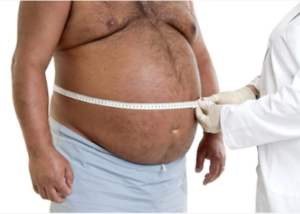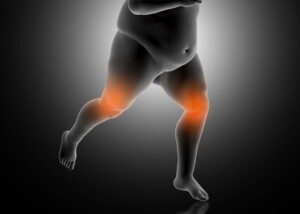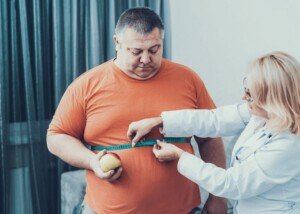
A morbidly obese influencer said that even doctors can’t tell a person’s health by looking at them.
How fast could she get up a flight of stairs? What would her wind be like once she reached the top?
Lexi, an influencer, appeared on “Dr. Phil,” insisting that you can be healthy and also morbidly obese.
Not surprisingly, like all like-minded influencers, she also appeared to be in her 20s, maybe early 30s at the most. She insisted she was healthy.
Her blood work was believably normal – being that she’s a young adult, and youth in many cases is an amazing protector against the ravages of obesity.
I was pleased to see a middle-age obese woman stand up and tell Lexi that when she was a young adult, she thought the same as Lexi.
She then explained that currently, she was paying the price for such denial and, among other obesity related conditions, needed knee replacement surgery and was scheduled for heart surgery.
This made me wonder, like I frequently do, why we don’t see middle-age, morbidly obese influencers claiming they’re healthy and fit.
Normal Blood Work
Blood work can be normal in morbidly obese people.
But basic blood work that’s taken during a routine physical will not show the systemic inflammation that obesity causes. This inflammation is a marker for heightened risk of many diseases.
Normal blood work will not show the significantly increased risk factors for the many illnesses that obesity leads to.
Nor will it show the substantial strain on the joints that obesity causes: Gravity exists.
A Doctor Can Tell Your Health by Looking at Your Body: 8 Conditions
#1 Height and Weight
“Even without measurements we get a rough idea of these things,” says Dr. David Beatty, MD, a retired general practitioner with 30+ years of experience and an instructor of general medicine for 20 years.
“If someone is obese it increases the chance of them having several medical conditions including diabetes, hypertension, high cholesterol and joint problems.”
So though the diabetes, high blood pressure and high cholesterol can’t literally be seen with the doctor’s eyes, he can see the significant risk factor or causative agent right before his eyes: an obese body.
As for joint problems, these can often be seen quite clearly when the obese person stands and especially walks.
For example, osteoarthritis of the knees often causes the legs to be bowed. This can’t be missed.
When an influencer insists that a person’s health can’t be determined by their “body type,” is she referring only to overweight people? How about markedly underweight bodies?
“If a person is underweight, particularly if there’s evidence of recent weight loss, it raises the possibility of malignancy, malnutrition, diabetes and hyperthyroidism, among other diagnoses,” says Dr. Beatty.
Just like it’s not normal to be obese, it’s not normal to be excessively underweight.
One might argue that marked thinness is normal in elite marathon runners and high jumpers, since they certainly take in enough calories to train hard several hours a day.
Elite athletes are atypical and may have a genetic predisposition to being very thin.
But keep in mind that there’d certainly be weight gain if they reduced their exercise to only one hour a day but kept the same caloric intake.

Though a doctor can’t always tell WHY a person is dangerously underweight, it’s certainly obvious from this photo — including to a layperson — that this individual is not healthy or fit. This person has a genetic condition, Marfan syndrome, which affects the heart and is characterized by a thin build. But Marfan’s doesn’t make a woman immune to anorexia nervosa, either. Mileny ES Colovati1, Luciana RJ da Silva1, Sylvia S Takeno1, Tatiane I Mancini1, Ana R N Dutra1,Roberta S Guilherme1, Cláudia B de Mello2, Maria I Melaragno1and Ana B A Perez1/creativecommons.org/licenses/by/2.0/Wikimedia Commons
Being too thin, by visible standards, can also mean that the person has porous weak bones – bones that are more likely to get broken in a car accident or tumble down the stairs.
#2 Leg Color
Venous insufficiency (vein malfunction) causes a classic purplish/red/brown coloration in the lower legs. Often, the legs are also noticeably swollen.
This painful, chronic disease has multiple risk factors, of which obesity is one.
“There are other factors that play a part in the development of chronic venous insufficiency,” says Dr. Beatty.
“The number of valves in the veins, the quality of the valves and other factors that cause a raised pressure within the veins.
“Morbid obesity plays a big part in raising the pressure within the large veins of the abdomen and legs.”
If you’ve ever seen someone with this condition, you will have noted that walking appears to be uncomfortable — because it is. A person with malfunctioning veins is not in a healthy state.
#3 Edema
A doctor can tell a person’s health by observing edema in their lower extremities.
This excess fluid can result from chronic heart failure, liver disease or kidney disease.
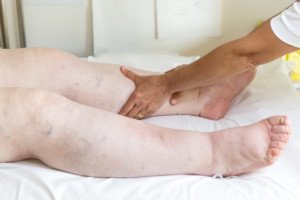
Edema. Shutterstock/Valerio Pardi
#4 Posture
“Looking at the spine may show evidence of excess curvature,” says Dr. Beatty.
“Kyphosis is when the spine is bent forwards, and scoliosis is when there is a side to side curve.
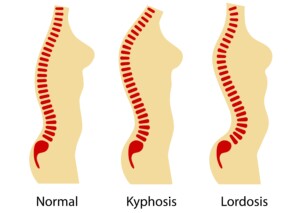
Shutterstock/Nemanja Cosovic
“Some people are born with this, and others develop it as the years go by. Injury, ankylosing spondylitis and osteoporosis [of which thinness with absence of weight bearing exercise is a risk factor] are some of the causes.”
Obesity can also result in poor posture, since the excess fat, combined with tight sedentary muscles, can pull the shoulders forward, causing the so-called gorilla stance.
This is often seen in obese children. A fit, healthy person should not have a gorilla stance.
Spinal stenosis is another type of spinal pathology, and people at a healthy weight can develop this as they age.
It’s visibly obvious as it gets worse, as shown in the image below.

Spinal stenosis
#5 Abdomen
Visceral fat, which is fat around the internal organs, is the most dangerous type of fat.
You can tell that a person’s organs are being subjected to harmful stress when they have a large amount of abdominal or midsection fat.

Dangerous excess visceral fat. Vidal httpscreativecommons.orglicensesby-sa2.0
A body scan is not needed to know that a person with a fat stomach is a person whose internal organs are being smothered.
One possible outcome of this is chronic gastroesophageal reflux disease. Chronic GERD is a risk factor for esophageal cancer.
A large stomach can also have other causes than just too many calories consumed.
Dr. Beatty explains, “Abdominal distension can occur with fibroids, ovarian cysts, ascites (fluid within the abdominal cavity), liver or splenic enlargement and some other large tumors.”
#5 Gait
“How a person walks can gives lots of information,” says Dr. Beatty.
“Parkinson’s disease causes difficulty initiating movement and a slow shuffling style with the arms hanging straight down.
“Cerebellar problems can cause a lack of coordination leading to a wide based stance which can be similar to a drunk person walking.
“Someone with knee or hip arthritis can walk with a limp favoring the good leg.”
Morbid obesity, and even moderate obesity, can cause what appears to be discomfort with walking, especially on a graded or uneven surface such as a parking lot or lawn.
The difficulty with ambulation will be even more apparent when the very overweight person goes up or down a flight of stairs.
#7 Musculature
“If muscles aren’t used they lose bulk. This can be seen in any muscle group, but muscle wasting is often seen in the quads following injury or inactivity.”
When a person with fit, strong legs has a seat, you’ll be able to see a slight rounding of their quadriceps muscle group. There will be a shape or firmness, and it will often be noticeable when they’re standing as well.
If they’re sedentary, the front of their thighs may be slightly concave, or subtely depressed. This will be more noticeable in thinner people.
A very obvious example is what we see in someone who’s been using a wheelchair for a long time.
But able-bodied people who never exercise can definitely have a visible atrophy in their thighs.
We can tell by looking at such legs that this is a person who, despite being able-bodied, is not physically fit, and is probably not healthy in terms of risk for future disease.
It’s a safe bet that a person whose quads look sunken when seated probably doesn’t do much structured exercise, let alone highly effective moves such as the squat, deadlift and lunge.
They probably can’t run well across a parking lot. The flabby muscle will become increasingly relevant as this sedentary person gets older!
#8 Skin
“Rashes may be due to eczema, psoriasis, acne, septic spots, ringworm or impetigo — among many other causes,” says Dr. Beatty.
“Skin pallor may suggest anemia. The skin can have a yellow tinge with jaundice [signaling liver problems] or with renal failure.”
However, the so-called glowing or dewy skin does NOT mean someone is healthy!
It’s astounding the number of followers of influencers comment on how healthy their idol’s skin is in a photo or video.
You can have the healthiest, most glowing and dewy looking skin in the world and still be quite sick and inflamed on the inside!
Between the use of filters, lighting and makeup, anyone can make their skin appear super healthy.
“You Look Healthy” vs. “You Look Unhealthy”
So if we can’t judge a person’s health by their body, why is it that – when a follower tells an influencer she looks healthy – the influencer and her followers don’t challenge this assertion?
There are loads of comments about how healthy an obese influencer looks. There is seemingly no pushback with these comments.
But lo and behold, when someone comments that they don’t look healthy, or that they look unhealthy, there is a firestorm of criticism, namely the mantra of, “You can’t tell a person’s health by their body.”
What’s strangely peculiar is that this mantra doesn’t get applied to “You look healthy.” It’s a huge double standard.
Though a slender person walking past you on the street, who appears healthy, may in fact be battling cancer, coronary artery disease and kidney stones, we can definitely make many accurate assumptions when someone is obese or displays any of the aforementioned visible characteristics.
Also keep in mind that a slim or straight size person may seem fit if their body is concealed by clothing.
The slender guy in the suit may seem fit, but what does he look like in just swim trunks?
His quads may be atrophied from lack of exercise. He may have flabby arms, a sunken chest and excess fat in the middle.
He may be “skinny fat” and be at risk for future conditions for which a sedentary lifestyle is a major risk factor such as chronic heart failure, coronary artery disease and weak bones.
He may easily throw out his back, due to weak back muscles, picking up his young child. He may be raging sore the next day from helping a friend move.
 Dr. Beatty has worked in primary medicine, surgery, accident and emergency, OBGYN, pediatrics and chronic disease management. He is the Doctor of Medicine for Strong Home Gym.
Dr. Beatty has worked in primary medicine, surgery, accident and emergency, OBGYN, pediatrics and chronic disease management. He is the Doctor of Medicine for Strong Home Gym.
 Lorra Garrick has been covering medical, fitness and cybersecurity topics for many years, having written thousands of articles for print magazines and websites, including as a ghostwriter. She’s also a former ACE-certified personal trainer.
Lorra Garrick has been covering medical, fitness and cybersecurity topics for many years, having written thousands of articles for print magazines and websites, including as a ghostwriter. She’s also a former ACE-certified personal trainer.
.

